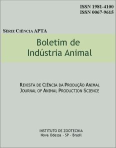Influência de intervalos de desfolha e de alturas do resíduo pós-pastejo sobre a produção e a composição da forragem e do leite em pastagens de capim-elefante
Palavras-chave:
Consumo voluntário, Pennisetum purpureum L. Schum., taxa de lotação, valor nutritivoResumo
Em pastagens de capim-elefante, tanto o intervalo de desfolha quanto a altura do resíduo pós-pastejo, podem influenciar, por hipótese, a produção e a composição da forragem e do leite. Assim, os objetivos deste trabalho foram avaliar os efeitos de dois intervalos de desfolha (24 e 30 dias) e de duas alturas de resíduo pós-pastejo (50 e 100 cm), em pastagens de capim-elefante cv. Napier sobre as características agronômicas e valor nutritivo do capim elefante cv. Napier, assim como a produção e composição química do leite de vacas mestiças Holandês x Zebu, durante a estação chuvosa. Foi usado o delineamento experimental de blocos completos casualizados com arranjo de parcelas sub-subdivididas, alocando-se, nas parcelas, os intervalos de desfolha, nas sub-parcelas, as alturas de resíduo e nas sub-subparcelas, os meses de avaliação. O acúmulo e o consumo voluntário de forragem somente foram influenciados pelos meses do ano, apresentando maiores valores de dezembro a abril (média de 1817 kg de MS ha-1) e em dezembro (2,5% do peso vivo), respectivamente. O valor nutritivo da forragem acumulada variou em função do período de avaliação, mas não apresentou tendência homogênea para os meses. A taxa de lotação foi maior durante os meses de novembro, dezembro, janeiro, abril (média de 4,1 UA ha-1) e a produção de leite em novembro e dezembro (média de 13,2 kg/vaca/dia). Os teores de proteína e lactose do leite variaram em função do mês do ano, sendo maior em maio para proteína (3,3%) e, aqueles de gordura e de sólidos totais, foram maiores para 24 que para 30 dias (médias de 3,9 e 12,2%, versus 3,7 e 11,7%, respectivamente). Na estação chuvosa, a pastagem de capim-elefante, foi capaz de proporcionar produções de leite e taxas de lotação médias de 11 kg/vaca/dia e 3,9 UA ha- 1, respectivamente.
Downloads
Downloads
Publicado
Edição
Seção
Licença
Os autores não serão remunerados pela publicação de trabalhos, pois devem abrir mão de seus direitos autorais em favor deste periódico. Por outro lado, os autores ficam autorizados a publicar seus artigos, simultaneamente, em repositórios da instituição de sua origem, desde que citada a fonte da publicação original seja Boletim de Indústria Animal. A revista se reserva o direito de efetuar, nos originais, alterações de ordem normativa, ortográfica e gramatical, com vistas a manter o padrão culto da língua e a credibilidade do veículo. Respeitará, no entanto, o estilo de escrever dos autores. Alterações, correções ou sugestões de ordem conceitual serão encaminhadas aos autores, quando necessário. Nesses casos, os artigos, depois de adequados, deverão ser submetidos a nova apreciação. As opiniões emitidas pelos autores dos artigos são de sua exclusiva responsabilidade. Todo o conteúdo deste periódico, exceto onde está identificado, está licenciado sob a Licença Creative Commons Attribution (CC-BY-NC). A condição BY implica que os licenciados podem copiar, distribuir, exibir e executar a obra e fazer trabalhos derivados com base em que só se dão o autor ou licenciante os créditos na forma especificada por estes. A cláusula NC significa que os licenciados podem copiar, distribuir, exibir e executar a obra e fazer trabalhos derivados com base apenas para fins não comerciais.













